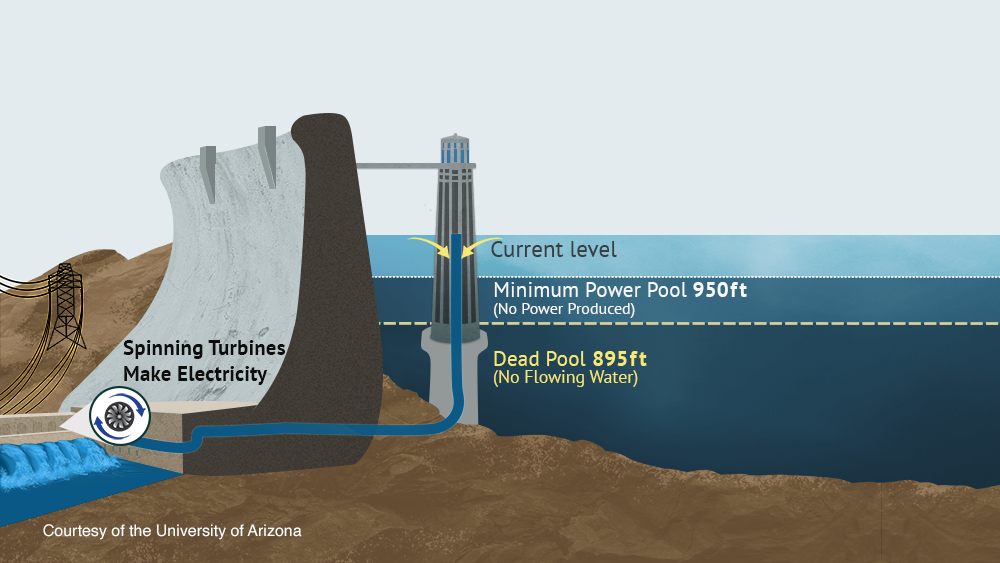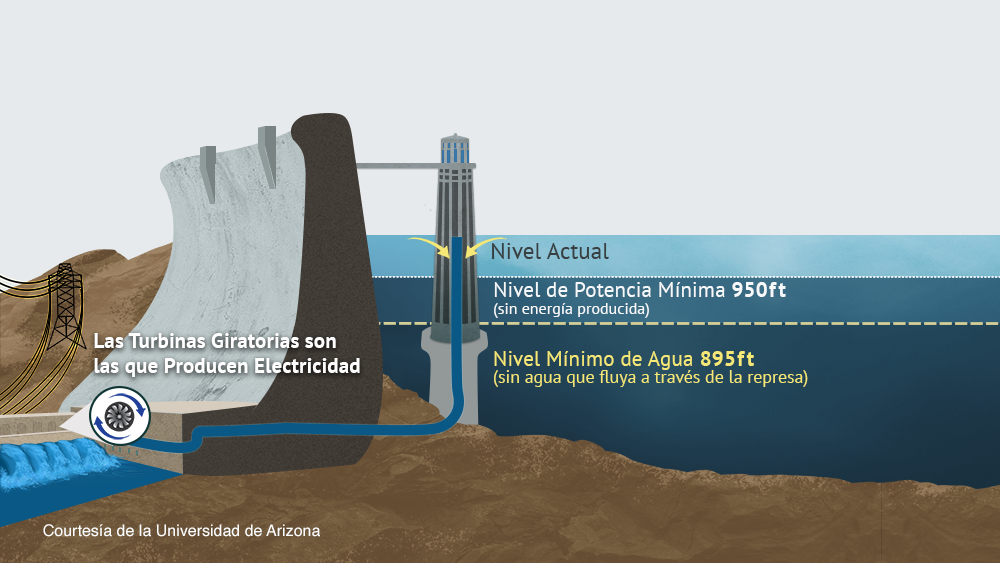Why will the Hoover Dam stop working before Lake Mead is empty?
The short answer:
Under normal operating conditions, water from Lake Mead flows through Hoover Dam, entering through structures in the intake towers and into penstocks (tunnels in the dam). Electricity is generated as the water spins turbines before exiting out the bottom of the dam.
If the water levels get too low, the turbines have to be turned off because they cannot operate safely (dangerous vibrations occur which can damage the turbines). This water level is called Minimum Power Pool. Water can still be released from the dam, but power can’t be generated from the releases.
If the water gets even lower, it can reach Dead Pool. At Dead Pool, the water level is below all intake structures. There is still water in the reservoir, but the flows downstream will be zero because there is no way for water to make it past the dam.
Media downloads:
| NAME | DESCRIPTION | SIZE | LENGTH |
|---|---|---|---|
| Hoover Dam Animation (zip) | Video with no voiceover or captions plus sample script | 16.9 MB | 37s |
Design team:
Student Developers:
Sofia Rodriguez, Wilzave Quiles Guzmán
Translator:
Wilzave Quiles Guzmán
Advisors:
Project Manager: Sara Kobilka
Science Advisor: Laura Condon
Graphic Designer:
Megan Roxbury
Infographic:
(click image to enlarge)
On Social Media:
Video Source: ABC15 Arizona
References and Additional Resources:
To learn more about this question checkout these resources:
- Rasmussen, Patty. “What If the Hoover Dam Broke?” HowStuffWorks Science, HowStuffWorks, 8 Mar. 2023
- Blazin’ Paddles, and Vegas Website Designs. “What Would Happen If the Hoover Dam Stopped?” Blazin’ Paddles, 20 Mar. 2023,
- Series, Discover our Shared Heritage Travel Itinerary. “Nevada and Arizona: Hoover Dam (U.S. National Park Service).” National Parks Service
¿Por qué dejará de funcionar la Represa Hoover antes de que el lago esté vacío?
La respuesta corta:
En condiciones normales de operación, el agua fluye a través de la Represa Hoover, ingresando a través de las estructuras en las torres de toma y en las tuberías forzadas (túneles en la represa). La electricidad se genera a medida que el agua hace girar las turbinas en el fondo de la represa.
Si los niveles de agua descienden demasiado, las turbinas deben apagarse porque no pueden funcionar de manera segura (se producen vibraciones peligrosas que pueden dañar las turbinas). Este nivel de agua se denomina nivel de potencia mínima. En este nivel de agua todavía se puede liberar agua de la represa, pero no se puede generar energía.
Si el agua baja aún más, puede llegar a “Dead Pool” ó en español, el nivel mínimo de agua en la represa. En este nivel, el agua está por debajo de todas las estructuras de toma. Todavía hay agua en el embalse, pero los flujos de aguas abajo serán cero porque no hay forma de que el agua pase la represa.
Materiales disponibles para descarga:
| TÍTULO | DESCRIPCIÓN | TAMAÑO | DURACIÓN |
|---|---|---|---|
| Hoover Dam Animation Espanol (zip) | Video sin voz y sin subtítulos | 16.3 MB | 37s |
El equipo de Diseño:
Estudiante Desarrolladores:
Sofia Rodriguez, Wilzave Quiles Guzmán
Traducta:
Wilzave Quiles Guzmán
Consejeros:
La Manejada del Projecto: Sara Kobilka
Asesa Científica: Laura Condon
Diseñador Gráfico:
Megan Roxbury
Infografía:
(haga clic en la imagen para ampliar)
Referencias y recursos adicionales:
Para obtener más información sobre esta pregunta, consulta estos recursos:
- Rasmussen, Patty. “What If the Hoover Dam Broke?” HowStuffWorks Science, HowStuffWorks, 8 Mar. 2023
- Blazin’ Paddles, and Vegas Website Designs. “What Would Happen If the Hoover Dam Stopped?” Blazin’ Paddles, 20 Mar. 2023,
- Series, Discover our Shared Heritage Travel Itinerary. “Nevada and Arizona: Hoover Dam (U.S. National Park Service).” National Parks Service


